The Evening Post international print collection
Masters student in Museum and Heritage Practice at Victoria University of Wellington, Clara Souza da Frota writes about how the overseas photographs of The Evening Post newspaper reflects the changing interests of New Zealanders over the years.
Reflecting New Zealanders' attitudes and interests
People’s opinions about the outside and the outsider are usually very personal. Unique experiences, personal relationships, and life events are some of the factors that mould how we perceive the world around us.
Newspapers are a great way to explore and understand public opinions and interests when it comes to major events. After all, this is an industry that heavily relies on knowing its target audience.
The Evening Post newspaper's international print collection (located at Series-6678) offers an amazing insight into the history of New Zealand journalism. The collection is comprised of photographic prints which are the work of overseas photographers and news agencies. Only the prints came to New Zealand and for these images no corresponding negatives are held by the Library.
The more than one hundred thousand prints not only tell the stories of global events and personalities, but also offer a new perspective on how the interests of New Zealanders have changed over the years.
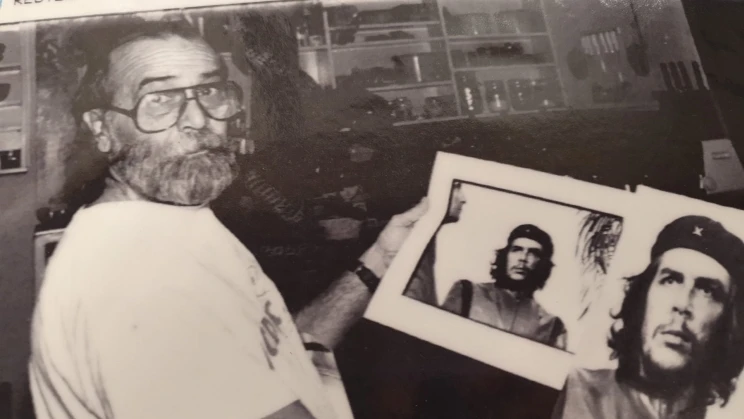
A picture of photographer Alberto Korda, the man behind the famous Ernesto Che Guevara portrait Ref: PAColl-10755-0508.
The Evening Post
Founded on 8 February 1865 by Henry Blundell The Evening Post was one of New Zealand’s oldest and longest-running newspapers. The paper remained a family business for the first century of its existence, only moving into corporate ownership in 1965. Over the years, The Evening Post saw a decline in readership, while at the same time its competitor, The Dominion started gaining traction, and in 1972 ownership of the papers was combined.
Eventually, after almost 140 years, The Evening Post newspaper published its last issue on 6 July 2002 and finally merged with The Dominion to become The Dominion Post that we know today.
Beginning in 1963 the Alexander Turnbull Library gradually acquired the photographic collections of The Evening Post. With the last acquisition made in 2003, this massive collection stayed almost untouched for nearly 10 years.
The collection was divided into two different series: the national and the international prints collections. As the national prints were given priority the international part of the collection remained in storage for almost 10 more years. It was only after the end of the national prints project (which featured in an earlier blog post) that the international prints began to be processed.
As I began processing the 208 boxes, I found that the collection was arranged in two sequences: portraits and subjects.
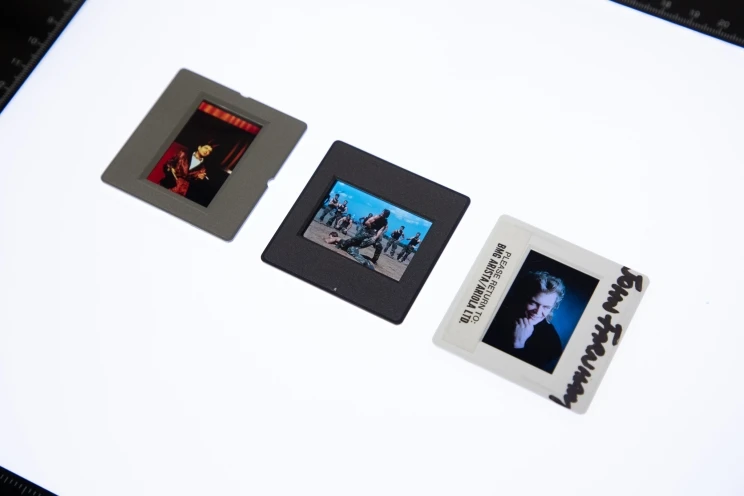
One of the unexpected formats found in the collection: Mounted transparencies. The collection contains a number of transparencies, some of the most interesting include 18th-century paintings, movie stills and politicians. Photo: Llewelyn Jones
A window into the past
At the time of publication, while processing of the collection is still in progress, the date range of the photographic prints is from 1927 to 2002. If the prints were re-arranged or viewed in chronological order, we would clearly see how the focus of society changed over the years. Highland log throwing (caber toss), ice skating, horse racing, and gardening competitions were some of the most common photos I found from the period 1927 to 1938.
It was fascinating to see how most of the older photos documented sports, athletes, and daily activities. However, from the 1940s a more impactful tone permeates the collection, with pictures of soldiers, politicians, and war machinery taking centre stage.

This year Mario the beloved Nintendo mascot commemorates its 35th anniversary, this photo was taken at the launch event of Super Mario 64 in 1996, when Mario games were only 10 years old. Ref: PAColl-10755-1027.
This tonal shift in the collection is fascinating, as through the prints one can see how society changed over the years. There was no more time for sports and gardening, suddenly there was only one thing people could think about — the War. However, amidst all the horror and anxiety I also found humorous and unusual prints dated from the 1940s. For me this was the highlight of the collection — between major historical events the international print collection contains some of the most humorous and quirky photos.
Learning history is a delight, living it is sometimes a nightmare. We all need a break, and the international collection is proof that even during the darkest times people still tried to find ways to lift their spirits.

Michael Jackson, Madonna, Saddam Hussein and even Mikhail Gorbachev, a weird photo of an international doppelgänger event found in one of the “Amusements” subject folders. Ref: PAColl-10755-1004.
Material history
Beyond documenting how New Zealand journalism and public interests changed over the years, the collection offers another great insight — showing how technology changed journalism. Thanks to the longevity of The Evening Post, and the prints comprising the collection, one is able to see how the newspaper was adapting to new decades.
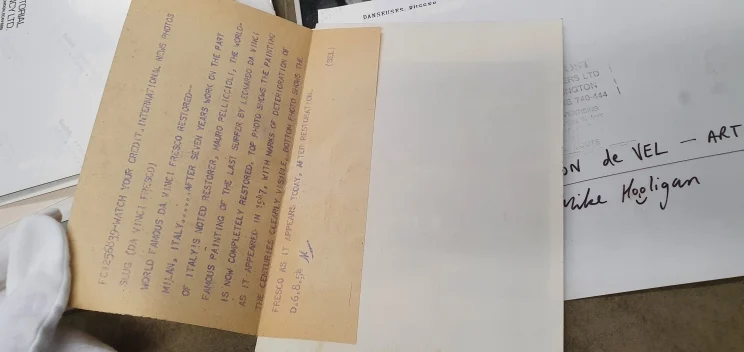
An example of the caption information affixed to the back of the print.
As I worked through the collection, I began to be able to estimate the date from the material used, the positioning of the description or caption, how the description is attached to the prints, the texture of the paper, and other characteristics. As technology evolved the quality of the material improved, description went from typewritten to printed, prints changed from black and white to colour. Each folder and each box offered a history of change. And these changes were most apparent in the subject sequence.
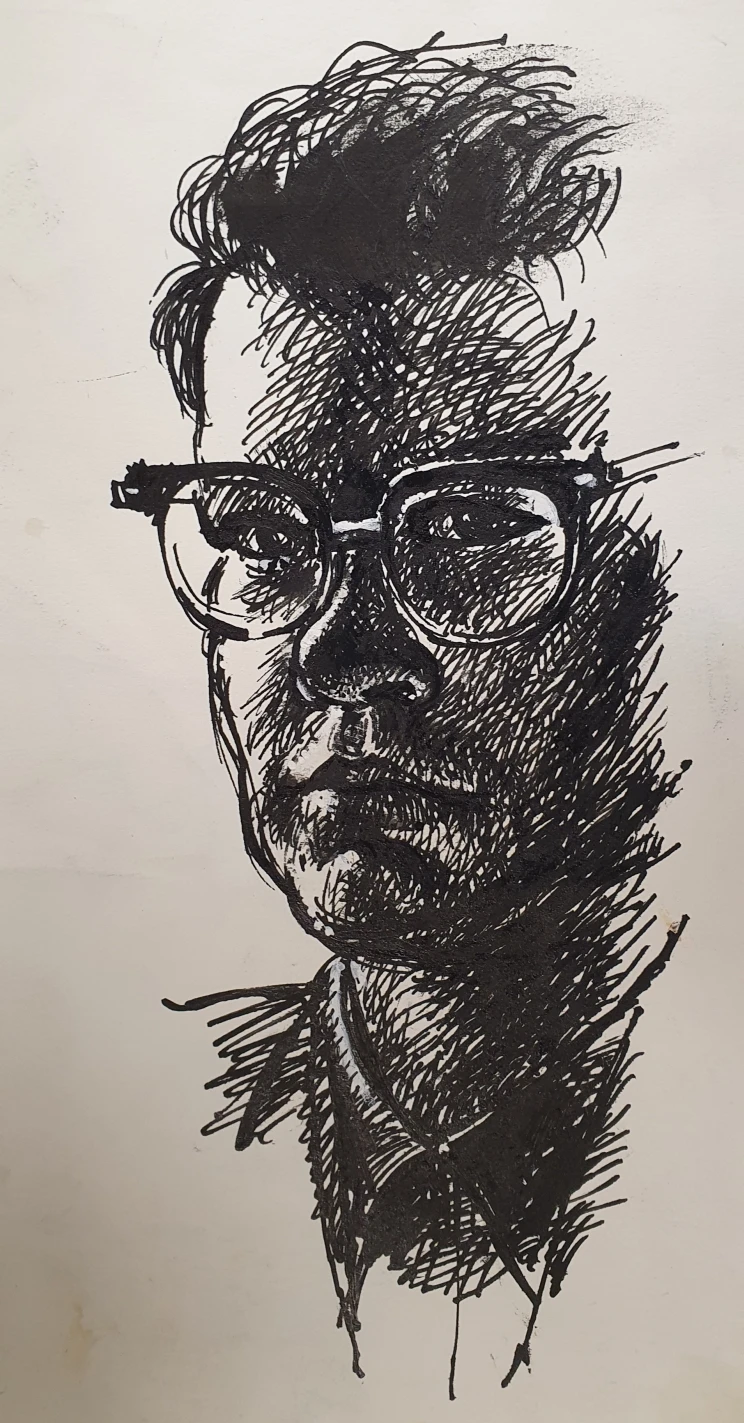
Original self-portrait of New Zealand artist William Jenks. This original drawing was found inside one of the subject folders on international art. Ref: A-480-010.
Marginalia
Personally, one of the most charming and interesting parts of the collection was finding draft articles, letters, envelopes, pamphlets, promotional material, and other non-print items amidst the prints. In the frenetic work of the newspaper office people forgot these objects inside folders. These items give a lot of personality to the collection: common work items becoming part of the documentary heritage of The Evening Post.
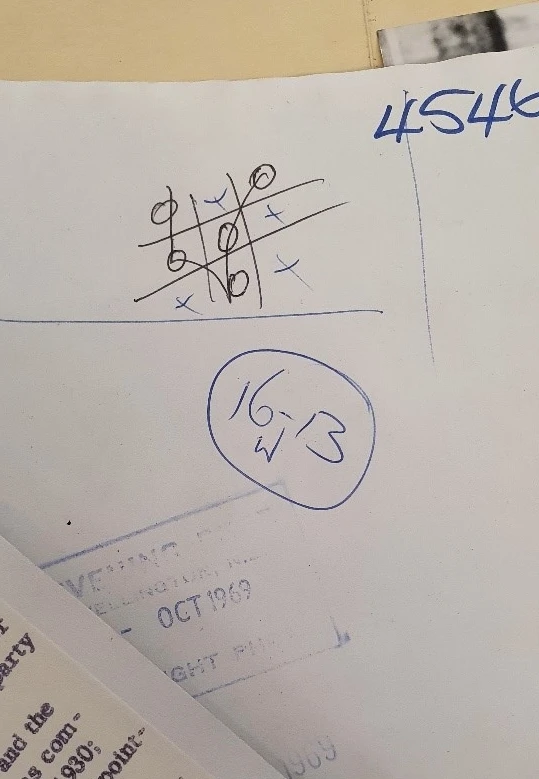
Game of Noughts and Crosses scribbled on the back of a print, dated 1969. Ref: PAColl-10755-0314.
While it was interesting to see the transition from black and white to colour prints the most intriguing development that I noticed was between the late 1980s and mid-1990s when the internet was established. A radical technological jump is evident from how few photographic prints there are from the period after the internet became widely used.

Promotional photo for the movie The Dark Crystal, released in 1982. The collection offers a large number of promotional movie prints. Prints were given exclusively to newspapers and media outlets for marketing; and some of the prints in the collection may never have been published. Ref: PAColl-10755-1088.
The majority of photos of the 2000s are part of promotional media. The technology that finally allowed people to have easy access to high-definition images was also the one that ended the need for the physical item.
Date stamps
Another interesting aspect of the photos are the date stamps. Date stamps are a good way to see which prints were published by the newspaper and how some subjects would come back in to the mainstream. For example, the collection has some photos that have been stamped and published 30 years after being issued, others getting published much more frequently and some that have never been used.
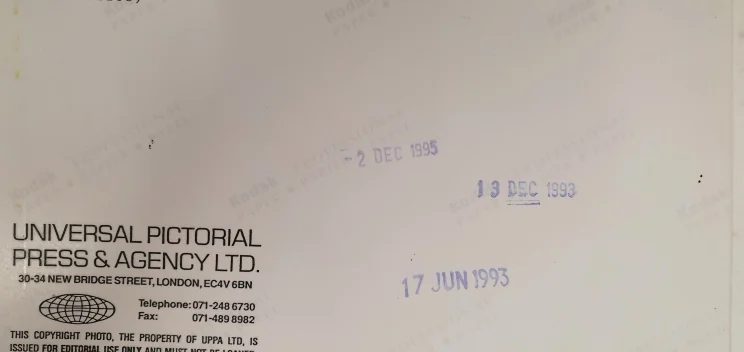
An example of the various stamps added to the back of the print, indicating when this particular image was published.
Conservation processing
PVC plastic is a well-known conservation hazard. PVC is the abbreviation of polyvinyl chloride a chemical that is widely used in plastic. Over time PVC degrades and can damage materials, mostly paper, around it. Therefore, part of my job was to remove any PVC enclosures I found inside the folders.

PVC plastic lamination on prints was common from the period 1985-1995. This type of lamination has proven to be a hazard to other prints in the collection. When the PVC lamination comes into contact with ink, for an extended period, it causes the ink to attach itself to the lamination, damaging the laminated print.
However, as I processed the collection, I noticed that many laminated prints produced between 1985 and 1995 shared the traits of PVC plastic. What tipped me off were the smell (PVC plastic smells like shower curtains), and the visual appearance: it wrinkles.
After discussing with my supervisors and the conservation specialist, we decided to conduct a Beilstein test to see if my observations were right. The Beilstein test is used to identify chloride in plastics.
How the test works: You melt the plastic sample into a copper wire and put the wire into a flame, if the flame turns green you get a positive for chloride. We did the test and the result was very clearly positive.
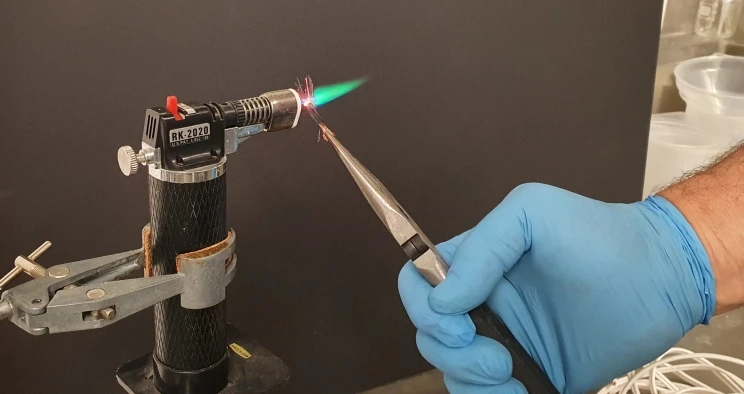
Our Beilstein test showed that the laminated print contained PVC, a compound that is damaging to paper and a hazard to other prints in the collection.
Now we know that a large percentage of prints from this time period were laminated with PVC and we are still trying to find the best solution for partitioning these prints from other non-PVC laminated materials housed in the same folders.
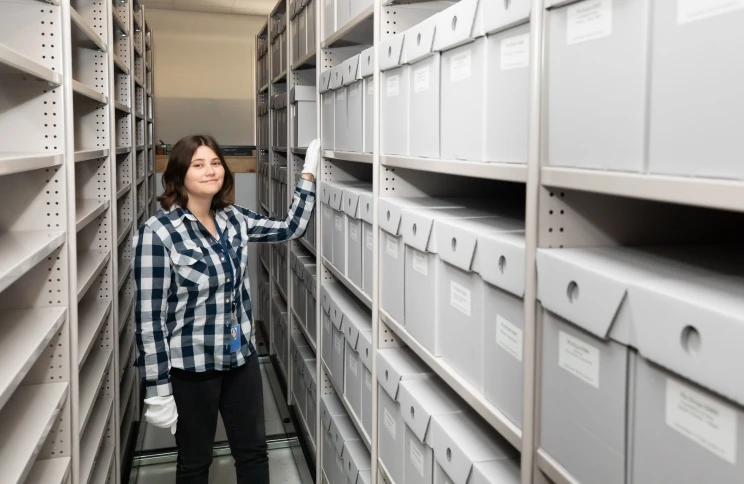
The author with The Evening Post international prints collection. Photo: Llewelyn Jones
An outside perspective
As an international student and an immigrant processing this collection was such an interesting job. It allowed me to understand more about New Zealand history and how New Zealand perceived the world around it during the years the newspaper was published.
Every time I saw prints of my country, Brazil, it was a bittersweet moment. To see historical events and figures that I know so well through the eyes of New Zealanders was fascinating but also helped me to understand more about the problems Brazil faces today as a society.
Sometimes we need a new perspective, an outsider perspective to understand more about ourselves and our own society.
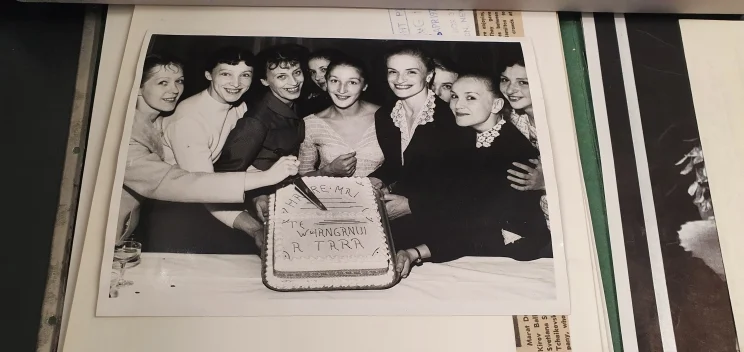
Bolshoi Ballet dancers during their visit to Wellington, the cake says “Haere mai! Te Whanganui-a-Tara”. Ref: PAColl-10755-1066.
Final thoughts
The Evening Post international prints collection is a fantastic resource full of potential and outstanding research value, with a wide variety of prints this collection, together with its national counterpart, can offer a peak at New Zealand’s journalism history.
For me, working with a team of professionals and unveiling the mysteries of the boxes together is what made this internship most memorable. I am happy that I had such a wonderful team for this project.
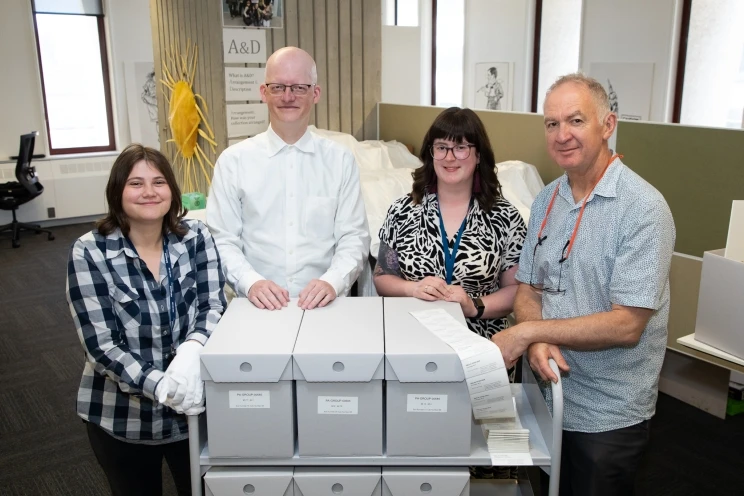
The Evening Post international print collection project team, from L to R: Clara Souza da Frota, Sascha Nolden, Amy Cosgrove, Mark Strange. Photo: Llewelyn Jones
Feliz em ver o lindo caminho que está fazendo, Clara! Acho que não lembra de mim, mas fiz parte de um pedacinho da sua história.